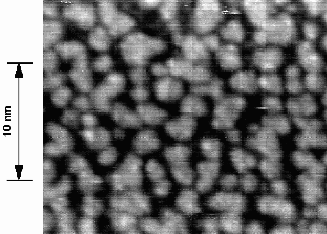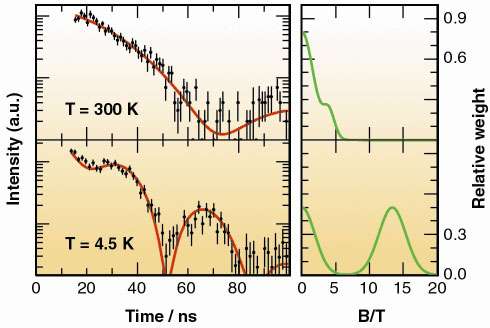- Home
- Users & Science
- Scientific Documentation
- ESRF Highlights
- ESRF Highlights 2001
- Magnetism and Electronic Properties of Solid
- Magnetic Order in Ultrasmall Iron Islands on Tungsten (110)
Magnetic Order in Ultrasmall Iron Islands on Tungsten (110)
The magnetic structure of nanoparticles is a fascinating research area with many new and unexpected results. Its relevance results from fundamental aspects of spin structure in low-dimensional systems and technological applications in fields like magnetic recording as well. Magnetism in low-dimensional systems relies on various kinds of anisotropies. A well-established model system is the pseudomorphic Fe monolayer on W(110) that exhibits a pronounced in-plane anisotropy.
At coverages below 0.58 monolayers, one observes the formation of stable and well-separated pseudomorphic islands with diameters of about 2 nm, as shown in Figure 95. These structures should exhibit a different magnetic order when compared to a continuous film, e.g. due to elastic strain and the change of interatomic distances. From previous studies it is already known that above 100 K these islands appear nonmagnetic due to thermal fluctuations of the magnetic moments (superparamagnetic relaxation). However, the magnetic order of these islands in the low-temperature regime has not been studied so far. Surprisingly, we found strong evidence for a perpendicular spin orientation in this system below 100 K.
 |
Fig. 95: STM image of Fe islands on W(110) at a coverage of 0.57 bulk monolayers, deposited at a temperature of 450 K. |
Studies of the magnetic order were performed at beamline ID18, employing nuclear resonant scattering at the 14.4 keV resonance of 57Fe. The Fe islands were prepared under UHV conditions on a clean W(110) surface, and coated with about five monolayers of Ag. Time spectra of the grazing-incidence reflectivity were recorded at various temperatures. Two selected data sets are shown in Figure 96. From the analysis of these spectra the magnitude and the orientation of magnetic fields in the sample can be derived [1]. The almost monotonous decay of the time spectrum at 300 K indicates the system to be nonmagnetic. At low temperatures an additional modulation appears in the spectra. This pattern is characteristic for a perpendicular spin orientation of the Fe islands with a magnetic hyperfine field of 13.5 T. The right panel in Figure 96 shows the hyperfine field distributions as obtained from the theoretical simulation (red lines).
 |
Fig. 96: Time spectra of nuclear resonant grazing-incidence reflection from ultrasmall Fe islands on W(110). While the data recorded at 300 K represent a nearly nonmagnetic state, the islands order magnetically at low temperatures with a perpendicular spin orientation. The corresponding hyperfine field distributions are shown in the right panel. |
To understand this unexpected magnetic ordering one has to investigate the contributions from different kinds of magnetic anisotropies if a continuous film breaks up into separated islands: First, due to the small island size the shape-anisotropy that favours an in-plane magnetisation is reduced, and, secondly, the relaxation of the elastic strain in the film leads to a strong contribution to the magneto-elastic anisotropy.
This interpretation is supported by a striking elastic behaviour in this system that has been observed recently [2]. Both contributions and the influence of the Ag capping layer finally change the total anisotropy to favour a perpendicular spin orientation. Future studies on size-selected nanoparticles will elucidate this relationship in more detail.
References
[1] Special issues about Nuclear Resonant Scattering of Synchrotron Radiation edited by E. Gerdau and H. de Waard, Hyperfine Interactions 123/124 (1999) and 125 (2000).
[2] D. Sander, A. Enders, and J. Kirschner, Europhys. Lett. 45, 208 (1999).
Principal Publication and Authors
R. Röhlsberger (a), J. Bansmann (a), V. Senz (a), K.L. Jonas (a), A. Bettac (a), O. Leupold (b), R. Rüffer (b), E. Burkel (a) and K.H. Meiwes-Broer (a), Phys. Rev. Lett. 86, 5597-5600 (2001).
(a) Universität Rostock, Fachbereich Physik, Rostock (Germany)
(b) ESRF



